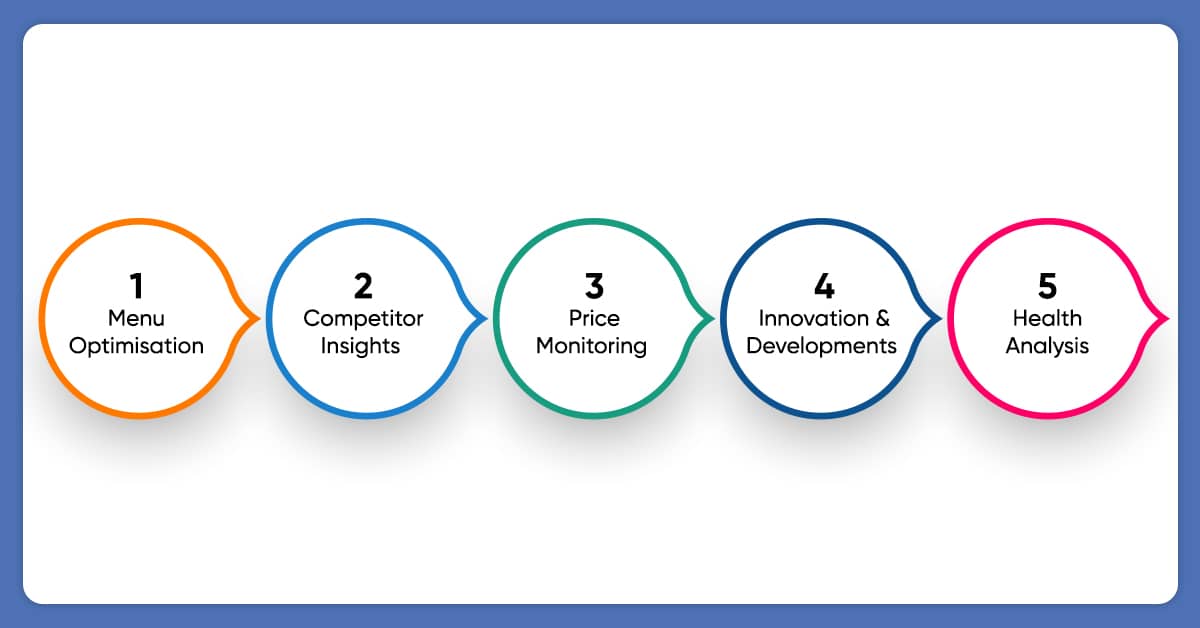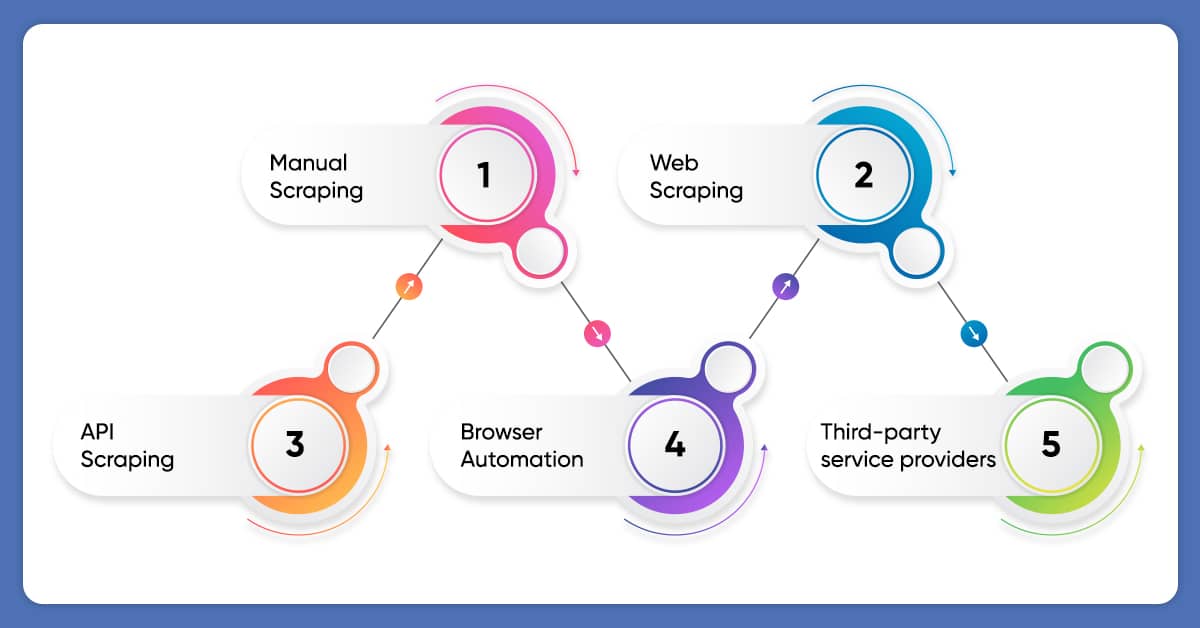Are you someone with an insatiable appetite for culinary exploration? It doesn’t matter if you’re a food blogger, someone who loves data, a business person, or a restaurant owner – having menu information from your favorite places can change how you experience the world of food. But how do we get this data? The secret is in restaurant menu scraping. A restaurant menu scraper is the most efficient tool to effortlessly transform and organize raw information. Pull up your chair to welcome the buffet of food data using restaurant food scraping tools. Let’s dig into Food Data Scraping and learn the tools and methods to help you grow your love for food.
What is Restaurant Menu Scraping?
Restaurant Menu Scraping is extracting the latest information on restaurant menus using web scraping techniques. This info could be menus themselves, the prices of dishes, pictures, descriptions, and nutritional information. This data is used in many ways, like studying the market, understanding what customers like, checking other restaurants’ prices, etc.
Why Restaurant Data Scraping?
Restaurant Data Scraping is valuable and essential for different industries like food, hospitality, health and nutrition, marketing, and data studies. Let’s look at why it’s so important to scrape restaurant data.
Menu Optimisation
Data scraping tools take menu information and food trends from all over the world from websites, social media, food delivery apps, and other platforms. This information helps determine popular food trends and improve your restaurant’s offerings.
Competitor Insights
Collecting and analyzing info from menus, restaurant reviews, and details from food delivery apps helps to make services better and make necessary adjustments to the existing menus.
Price Monitoring
Restaurant data scraping lets people and restaurant owners see competitors’ charges and deals. This helps customers who want to save money and new restaurant owners who want to attract customers and plan marketing efforts.
Innovation & Developments
With lots of important info in the food and health world, business people and app developers can create food-related apps. Businesses can develop healthy cuisines by researching what customers like and the health benefits of different food ingredients.
Health Analysis
Businesses focused on health and food research use the nutrition info of food items from different restaurants. Scraping food data can be a big help and contributes to understanding and spotting the health conditions of customers in a specific area.

Restaurant Data Scraper and How it Works?
Restaurant Data Scraper is a tool that automatically extracts needed info from websites, social media, review sites, and delivery apps to help businesses make good choices. Here’s usually how scraping restaurant data works.
Identify the source
The scraper must know where to get the data based on your desired data. This can include the restaurant’s name, food items, prices, images, and descriptions. The data source could be a website, a food delivery app, a restaurant’s menu and order system, or review sites. After setting goals and needs, the crawler tool will go through the search engine to make a data collection.
Choose the Scraper
Many free and paid tools and websites help you get data from your desired sources. It’s essential to pick the right one based on features, how it works, and your budget. Some options include using tools like Beautiful Soup or Scrapy in Python or working with HTML, APIs, or even manual scraping, which can be used depending on how much data you have.
Parse HTML & Execute
After deciding on the type of data, where you’re getting it from, and the right tool, the scraper needs to parse the HTML code to find the specific parts of the data. This can be done with regular expressions or Xpath containing element IDs, classes and other attributes. When the scraper finds the right parts in the HTML, it will extract the data and turn it into an organized format.
Processing the Data
The data you get might be in formats like CSV, JSON, XML, or Excel files, and usually challenging to use. The scraper stores the data you want in a structured format in a database. Then, you can use this data for analysis or to generate reports.
Restaurant Data Types
The extracted data can be categorized into different types. Each type gives you insight into various parts of the restaurant business. Let’s look at the common types of restaurant data that people usually scrape.
Restaurant Information: This has simple info like the restaurant’s name, address, phone number, website links, directions to get there, images, reviews, and social media links.
Menu Data: This has menu details like the names of dishes, descriptions, categories (like appetizers, soups, main courses, desserts, drinks, etc.), ingredients, food choices for different diets, and prices. Some menus also show info about allergens, nutrition, and unique dishes from the chef.
Pricing Data: This has all the prices, like how much single dishes cost, meal deals and packages, different prices at various times of the day, and costs or fees for delivery.
Review Date: This includes details from the review section like the reviewer’s name, ratings, comments, when the review was written, comments, and ratings for specifics like the food, atmosphere, service, and overall ratings.
Operational Data: This includes info about when the restaurant opens and closes, holidays, events, options for delivery and takeout, any other services they offer, any special deals or promotions, and loyalty programs for customers.
Methods of Restaurant Menu Data Scraping
Depending on the size of the data and budget, you can choose the right food data scraping that best suits your requirements. Here are the primary scraping methods:
Manual Scraping
Manual scraping is a straightforward approach that involves manually extracting data from websites and other online sources. This is very time-consuming, error-prone, and not scalable for extensive data.
Web Scraping
This is the most common method to scrape restaurant data. It involves using automated programming tools or scripts to extract directly from desired sources. This allows you to parse HTML code to locate specific data elements. It also contains libraries in Python like Beautiful Sopa, Scrapy, or Octoparse.
API Scraping
API scraping is getting data using APIs that a platform provides. APIs help interact, access, and extract information in an organized way. To use API scraping, you need an understanding of programming languages like Python and Java to call the APIs and process the data.
Browser Automation
Browser Automation is the most effortless scraping process. Automation tools like Selenium allow interaction directly through the browser. This method is used for scraping real-time data from dynamic content websites.
Third-Party Service Providers
If you need more tech skills or your in-house staff to scrape the data, you can hire someone else to get the data for you. Even though it is costly, it gives you data you can use immediately without any technical problems.

Choosing the Right Method
The right way to get a restaurant menu or food data depends on your needs, desired data, and budget. Small projects or businesses with a tight budget can manually scrap or use a simple web scraping tool. Big companies or ones that need up-to-date, organized data should choose API scraping or pay a third party to do it for them.
Ethical Considerations
When scraping data, there is still a grey area; not all companies or establishments readily agree to access and download their data. It is essential to follow ethical practices while scraping data from any website or platform. Here are some key considerations:
- Scrape responsibly and ethically without violating privacy policies and intellectual property rights.
- Do not send continuous calls or requests; it could overload the server, disturb the website’s operations, and raise the chances of blocking your IP address.
- Access website terms & conditions and privacy policies and obtain permission from the website owner before attempting scraping.
- Use the data responsibly; the data might contain customers’ personal information. The data is only meant for market analysis and to identify food trends. Send your data usage terms to the website owner to ensure transparency.
Conclusion
As we conclude, let us recap the important takeaways. Restaurant menu scrapers or food data scraping tools have emerged as the most potent tools to unlock customer preferences and identify emerging trends. These global insights from the menu are revolutionizing culinary, health nutrition, and other innovations. Whether you are a small business starting or an enterprise seeking to expand, there is a right scraping method that fits right. Now that you have all the information explore the culinary landscape, new dining options, and healthy options through restaurant menu scraping. Empower your decisions with invaluable data and open up a world of possibilities in the food industry. Foodspark is a leading Food Aggregator and data-scraping service provider. We offer well-organized food and restaurant data to fulfill all your business requirements. Get your data from Food Spark and cook up your success.
Comments on “Restaurant Menu Data Scraping: An Effective Way to Data-Driven Approach”